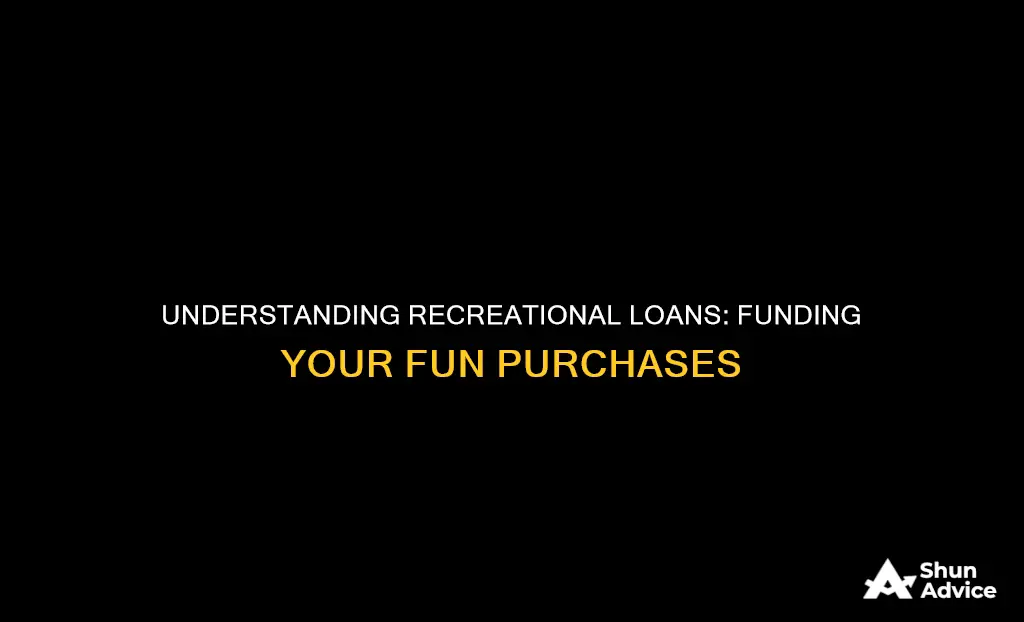
Recreational loans are a type of credit used to help people buy vehicles and gear for outdoor activities. They are often used to finance boats, RVs, motorbikes, ATVs, and other outdoor equipment. These loans are usually secured loans, with the acquired asset acting as security for the lender. Loan terms and interest rates can vary significantly depending on various factors, and borrowers must consider not just the loan installments but also insurance, maintenance, and operational costs. Recreational loans provide an opportunity for people to fund their hobbies and outdoor pursuits, but careful financial planning is necessary to ensure financial security.
| Characteristics | Values |
|---|---|
| Purpose | To assist people in buying recreational vehicles and gear for outdoor activities |
| Vehicles | RVs, campers, motorhomes, boats, jet skis, ATVs, snowmobiles, scooters, motorbikes, off-road vehicles, wave runners |
| Interest Rates | Fixed, providing clear financial planning |
| Lenders | Traditional banks, credit unions, online lenders |
| Down Payment | 10% to 20% of the purchase price |
| Loan Terms | Up to 10 years |
| Credit Score | A higher score results in more favourable loan terms and lower interest rates |
| Pre-approval | Available at some lenders |
What You'll Learn
- Recreational loans are a type of credit used to buy vehicles and gear for outdoor activities
- They can be used to finance a range of vehicles, including boats, RVs, motorbikes, and ATVs
- Recreational loan terms and interest rates can vary significantly depending on various factors, including creditworthiness and lending institution rules
- A credit check is required for a recreational loan, with a higher credit score resulting in more favourable loan terms
- Recreational loans are often more complex, so it's important to have the right partner to help navigate the process

Recreational loans are a type of credit used to buy vehicles and gear for outdoor activities
Recreational loans are a type of credit used to fund outdoor leisure activities. They can be used to purchase recreational vehicles (RVs), campers, motor homes, boats, jet skis, and other outdoor gear. These loans are typically secured loans, with the acquired vehicle or equipment acting as collateral.
Recreational loans are often referred to as "toy loans" or "leisure loans" and are tailored to those looking to invest in recreational vehicles and equipment. They are usually offered by credit unions, banks, or online lenders and can provide funding for up to 100% of the purchase price, with loan terms ranging from 12 months to 10 years. The interest rates on these loans are often fixed, providing borrowers with predictable monthly payments.
The process of applying for a recreational loan is similar to that of a regular instalment loan. Borrowers approach their preferred financial institution and, upon acceptance, receive a lump sum of money specifically for the purchase of their chosen recreational vehicle or equipment. It is important to note that interest rates and loan terms can vary significantly, influenced by factors such as creditworthiness, lending institution policies, and market conditions.
Before applying for a recreational loan, it is essential to assess your financial situation comprehensively. While these loans can make outdoor adventures more accessible, they come with additional costs such as insurance, maintenance, fuel, and storage. A solid credit score can help secure more favourable loan terms and lower interest rates. Obtaining pre-approval or prequalification can help determine your budget and streamline the purchasing process.
Missing Documents: Nelnet Loans and National Collegiate's Impact
You may want to see also

They can be used to finance a range of vehicles, including boats, RVs, motorbikes, and ATVs
Recreational loans are a type of credit used to help people buy vehicles and gear for outdoor activities. They are often called "toy loans" or "leisure loans". They can be used to finance a range of vehicles, including boats, RVs, motorbikes, and ATVs. This allows borrowers to purchase the vehicle they want and pay in instalments.
Recreational loans are available for both new and used vehicles. The average cost of a boat can range from $15,000 for a bowrider to a minimum of $300,000 for a yacht. For an RV, the cost can range from $10,000 to $300,000, depending on the age, features, and whether it is new or used.
The loan terms for recreational loans can vary, with some loans offering terms of up to 10 years, which is longer than the typical auto loan. This gives borrowers more time to pay off the balance and lowers the monthly payment amount. It is important to carefully review the interest rate and loan conditions, as these directly affect the total cost of the loan.
To apply for a recreational loan, borrowers typically start by approaching their preferred financial institution, such as a bank, credit union, or online lender. It is recommended to get pre-approved for a loan before shopping for a vehicle, as this can help speed up the purchasing process and provide clarity on budget constraints.
Seller's Role in FHA Loan Process: What to Know?
You may want to see also

Recreational loan terms and interest rates can vary significantly depending on various factors, including creditworthiness and lending institution rules
Recreational loans are a type of credit used to help people buy recreational vehicles and equipment for outdoor activities. They are often referred to as "toy loans" or "leisure loans". These loans allow borrowers to purchase boats, tents, RVs, motorbikes, and more, opening doors to a world of outdoor adventure.
The type of recreational vehicle you are looking to purchase can also affect the interest rate you will receive. For instance, My Financing USA's rates depend on factors such as the amount being financed, the type of RV, the age of the RV, your location, your credit score and your credit history. The cost of insurance for your recreational vehicle is another factor to consider, as this will depend on the size of your vehicle. For instance, while a small pop-up camper might cost you $100 annually in insurance, a luxury motorhome could be upwards of $1,500.
The lending institution you choose to borrow from will also affect the terms and interest rates of your loan. Credit unions, for example, are often able to offer more favourable terms on your loan as they are not-for-profit organizations. It is important to shop around and compare what different lenders are willing to offer you, as LendingTree notes that some lenders may offer unique perks like APR discounts or fee-free loans.
Understanding Carry Back Loans: A Smart Financial Strategy?
You may want to see also

A credit check is required for a recreational loan, with a higher credit score resulting in more favourable loan terms
Recreational loans are a type of credit used to help people buy vehicles and gear for outdoor activities. They are commonly used to finance boats, RVs, motorbikes, and ATVs, but they can also be used for other vehicles, such as snowmobiles, campers, and personal watercraft. These loans are often referred to as "toy loans" or "leisure loans".
When applying for a recreational loan, a credit check is required, and a higher credit score will result in more favourable loan terms. The credit check will play a pivotal role in the lending situation, as it does with any loan. A solid credit score means you are more likely to receive lower interest rates. It is also important to ensure there are no errors in your credit reports. You can check these for free at AnnualCreditReport.com, which offers reports from major credit bureaus.
The interest rate and loan conditions of a recreational loan should be carefully reviewed, as they directly affect the total cost of the loan. Recreational loans usually fall into the secured loan category, meaning that the acquired recreational vehicle or equipment acts as security for the lender. The loan terms cover the timeframe for repayment and can range from brief intervals, such as 12 months, to longer terms of up to 10 years, particularly for more expensive vehicles.
It is important to note that insurance, maintenance, fuel, and storage costs should also be factored into your financial planning when considering a recreational loan. These additional costs can vary depending on the size of the vehicle and whether it is a watercraft or RV.
Understanding ULIs: How They Change in Purchased Loans
You may want to see also

Recreational loans are often more complex, so it's important to have the right partner to help navigate the process
Recreational loans are a type of credit used to assist people in purchasing recreational vehicles and equipment for outdoor activities. These loans are often referred to as "toy loans" or "leisure loans". They are a great way to finance your leisure time fun and make your dreams of owning a recreational vehicle a reality. Whether you're dreaming of spending your days camping, boating, or snowmobiling, a recreational loan can help you achieve your goals.
Recreational loans can be used to finance a wide range of vehicles and equipment, including RVs, motorhomes, campers, boats, jet skis, motorbikes, ATVs, snowmobiles, scooters, off-road vehicles, and more. They can be used to purchase both new and used items, and the average cost can range from $15,000 for a boat to a minimum of $300,000 for a yacht. For an RV, you can expect to spend between $10,000 and $300,000.
Recreational loans tend to be more complex than other types of loans, similar to a mortgage. This is because they often involve a large amount of money and can have long loan terms, ranging from brief intervals of 12 months to longer terms of up to 10 years. The interest rates on recreational loans can also vary significantly, and it is crucial to carefully review the interest rate and loan conditions as they will directly affect the total cost of the loan. Additionally, the down payment criteria will vary by lender, but it is generally recommended to put down 10% to 20% of the purchase price.
Because of the complexity of recreational loans, it is important to have the right partner to help navigate the process. A credit union is often the best option, as they are uniquely positioned to put their members first and offer excellent rates, personal attention, and favourable terms on loans. They may also provide members-only insurance discounts and convenient tools such as online applications and loan calculators. By getting prequalified for a recreational loan, you can know exactly how much you can afford and make the purchasing process smoother.
Assumable Commercial Loans: What You Need to Know
You may want to see also
Frequently asked questions
A recreational loan is a type of credit used to help people buy vehicles and gear for outdoor activities.
You can use a recreational loan to finance a variety of vehicles, including boats, RVs, motorbikes, ATVs, snowmobiles, scooters, and off-road vehicles.
Recreational loans allow borrowers to purchase vehicles and equipment for outdoor adventures. They also provide fixed interest rates, making financial planning easier and giving borrowers stability in their monthly payments.
To get a recreational loan, you need to apply at your preferred financial institution, such as a traditional bank, credit union, or online lender. Before applying, it is important to review your finances, get a credit check, and find the right lender.







